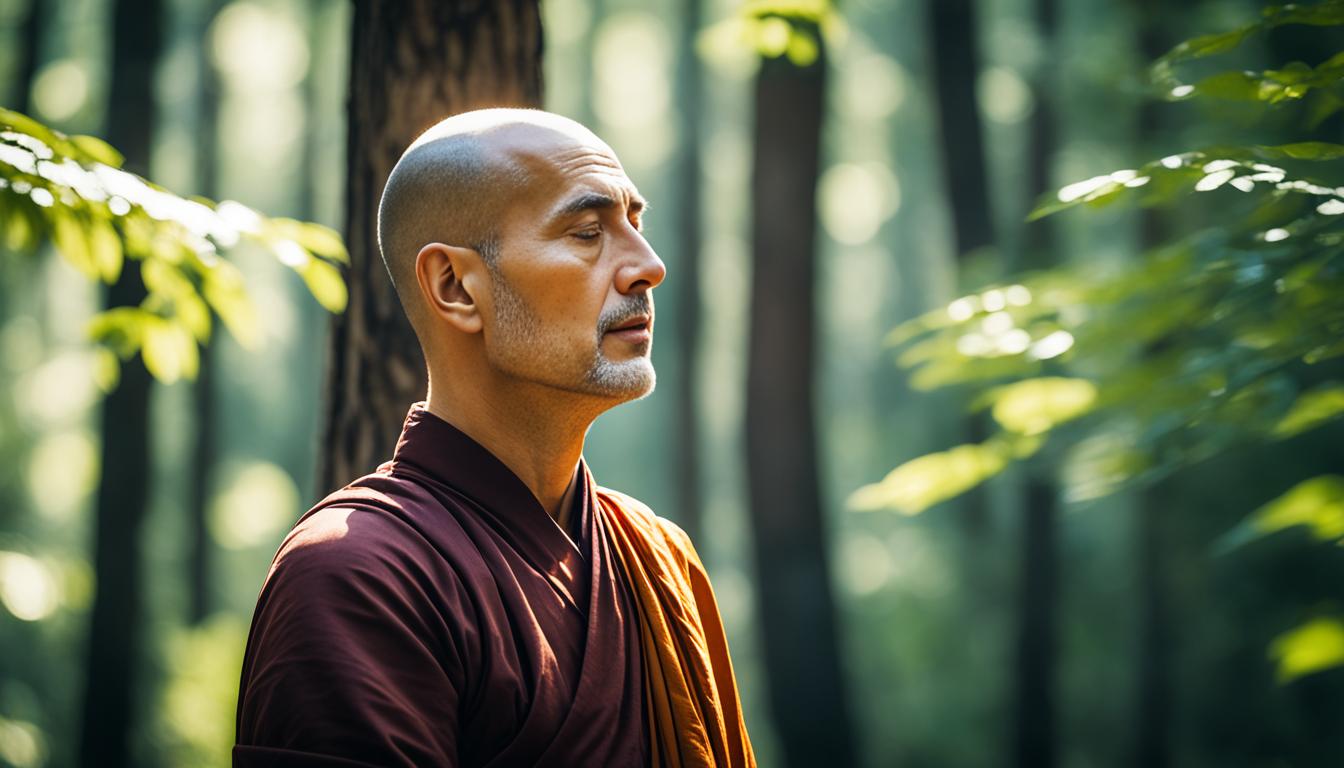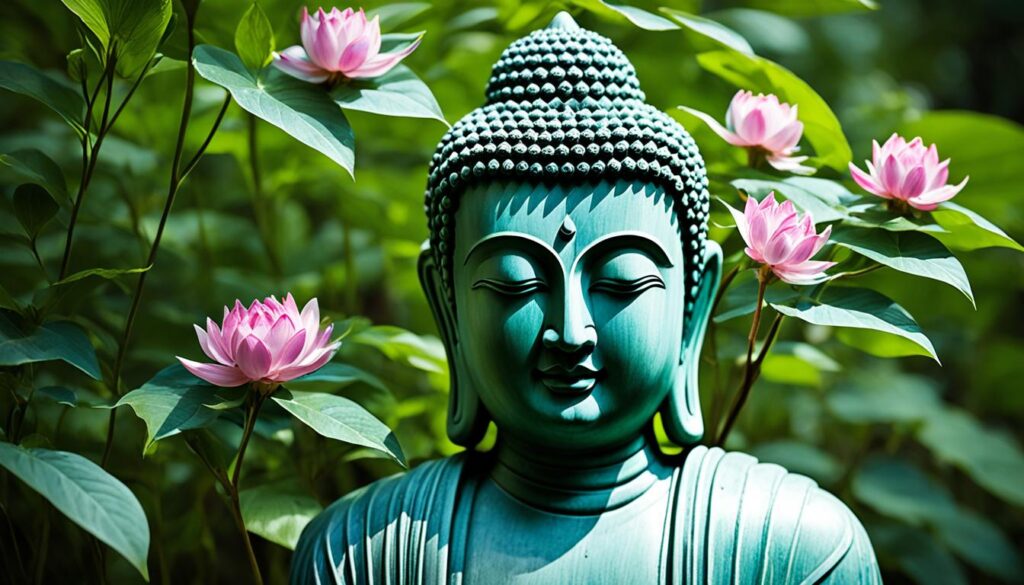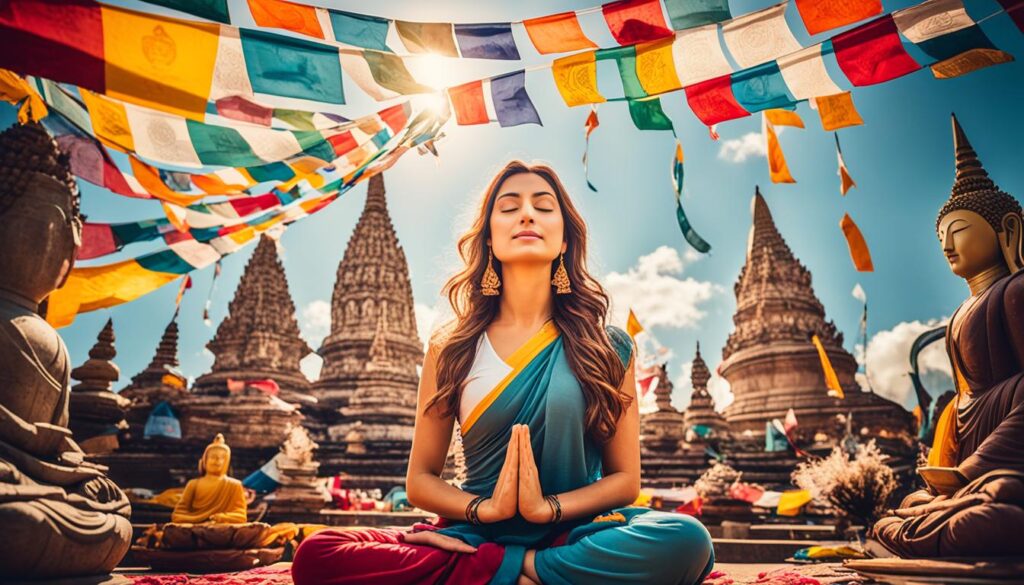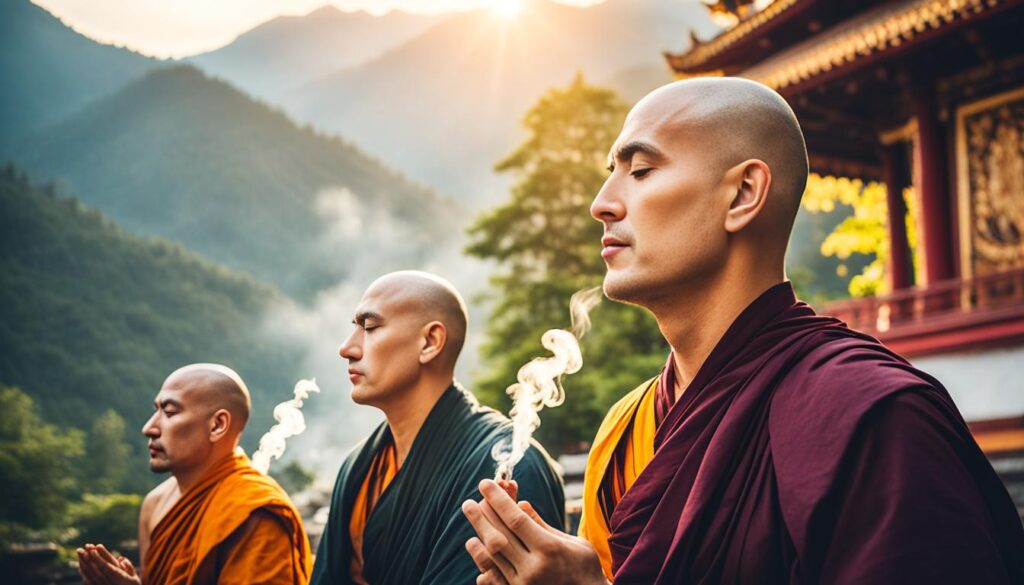
Have you ever wondered why Buddhists have long hair? It’s a question that challenges common beliefs and evokes curiosity about the significance of hair in Buddhist culture. From the distinctive hairstyles of tantric practitioners to the role of hair in representing spiritual purity, the reasons for long hair in Buddhism are multifaceted and intriguing. Let’s delve into the traditions, beliefs, and symbolism surrounding long hair in Buddhism to unravel this fascinating phenomenon.
Key Takeaways:
- The long hair of tantric practitioners, known as ngakpa, is a defining characteristic of non-monastic religious specialists in Tibetan Buddhism.
- Tantric hairstyles in Tibetan Buddhism intersect with bodily, social, and political aspects of tantric practice and are associated with embodied divinity and ritual power.
- The portrayal of the Buddha with short and tight ringlet curls in statues symbolizes the abandonment of ignorance and the pursuit of spiritual purity.
- Hair holds social, religious, and erotic significance in Buddhist culture, with monks and nuns keeping their hair shaved to symbolize non-attachment.
- Various hair practices exist in different Buddhist traditions, ranging from shaved heads to dreadlocks, reflecting cultural variations and individual choices.
The Cultural Grammar of Tantric Hairstyles in Tibetan Buddhism
The cultural grammar of tantric hairstyles in Tibetan Buddhism, particularly in the Repkong area, is an intriguing subject of study. Tantric hairstyles, including the twisted dreadlocks, serve as an overdetermined religious identity marker for tantrists. These hairstyles intersect with the bodily, social, and political aspects of tantric practice and are associated with embodied divinity and ritual power.
While there is variation and inconsistency in the codification of hair practices and ideas among tantrists, an ethnographic inquiry can provide valuable insights into this unique cultural phenomenon.
The Hairs of the Buddha
The portrayal of the Buddha in statues and paintings often depicts him with short and tight ringlet curls. The historical accounts of the Buddha’s hair vary, with some suggesting that he shaved his hair completely while others mentioning that he lost the longer portions of his hair. The cutting of the hair symbolizes the abandonment of ignorance and the pursuit of spiritual purity. However, the representations of Buddha heads and statues are not accurate physical depictions of the historical Buddha and instead focus on symbolizing his knowledge and enlightenment.

Throughout history, the Buddha’s hair has been a metaphorical representation of his journey towards enlightenment. The symbolism behind the Buddha’s hair extends beyond its physical appearance and acts as a visual reminder of spiritual purity and liberation from worldly attachments.
While the exact hairstyle of the historical Buddha remains uncertain, his depictions in art serve to convey important spiritual concepts. The short and tight ringlet curls, seen in Buddha statues and heads, represent the shedding of earthly desires and the attainment of inner peace.
The cutting of the hair, whether completely or partially, is a symbolic act that signifies the renunciation of worldly attachments. It serves as a metaphorical release from ignorance and ego, allowing for the pursuit of spiritual awakening and enlightenment.
“The cutting of the hair symbolizes the abandonment of ignorance and the pursuit of spiritual purity.”
The representation of the Buddha’s hair in art emphasizes his role as a spiritual teacher and guide. The focus is not on physical accuracy but rather on conveying the essence of his teachings and the path to liberation.
The portrayal of the Buddha’s hair in statues and paintings is a visual reminder of the transformative power of spiritual practice. It serves as a symbol of the Buddha’s wisdom and enlightenment, inspiring others on their own spiritual journeys.
By contemplating the symbolism of the Buddha’s hair, individuals can reflect on their own path towards spiritual growth and embrace the teachings of non-attachment, compassion, and inner peace.
The Significance of Hair in Buddhist Culture
Hair holds immense significance in Buddhist culture, encompassing various social, religious, erotic, and psychological aspects. In ancient Indian traditions, hair was considered a symbol of beauty, with specific hairstyles, such as plaits and buns, being popular among both men and women.
Within the context of Buddhism, the practice of shaving the head holds particular religious symbolism. Monks and nuns are encouraged to keep their hair shaved for hygienic purposes and to discourage vanity. The act of shaving one’s hair represents non-attachment to worldly appearances and the pursuit of spiritual enlightenment.
By forsaking attachment to physical appearance through shaving their heads, monks and nuns emphasize the importance of inner beauty and spiritual development. This practice serves as a constant reminder of the impermanence of all things and the desire to detach oneself from materialistic pursuits.
Furthermore, the act of shaving one’s hair symbolizes a commitment to cleanliness and hygiene. In the monastic community, where close-quarters living is common, maintaining short hair contributes to maintaining cleanliness and preventing the spread of diseases.
“The shaving of the hair symbolizes the eradication of ego and attachment to worldly ideals, allowing for a deeper connection with the divine.”
Traditional hairstyles in Buddhism, particularly among monks and nuns, reflect the underlying spiritual principles of the religion. The shaved head represents a rejection of vanity and attachment to external appearances, redirecting one’s focus towards spiritual development and the pursuit of enlightenment.
Table: The Importance of Hair in Buddhist Culture
| Aspect | Significance |
|---|---|
| Social | Hair as a symbol of beauty and cultural identification |
| Religious | Shaved heads signify non-attachment and spiritual enlightenment |
| Erotic | Historical association between hair and erotic appeal |
| Hygiene | Shaving promotes cleanliness and prevents the spread of diseases |
| Psychological | Emphasizes inner beauty and non-attachment to worldly ideals |
The spiritual relevance placed on hair in Buddhist culture underscores the importance of self-reflection, non-attachment, and the pursuit of enlightenment. It serves as a tangible reminder for practitioners to detach from the transient nature of physical appearances and focus on the inward journey towards spiritual fulfillment.

Hair Practices in Buddhist Traditions
Various hair practices exist in different Buddhist traditions. Monks and nuns follow specific religious requirements regarding their hair, while ascetics have their own distinct practices. Here are some common hair practices observed within Buddhist communities:
Monks and Nuns
In many Buddhist traditions, monks and nuns are expected to keep their heads shaved as a symbol of renunciation and detachment from worldly desires. Shaving their heads represents their commitment to a simple and humble lifestyle, focusing on spiritual cultivation rather than personal appearance.
Ascetics
Ascetics, who may include practitioners living outside of monastic institutions, often choose alternative hair practices to express their spiritual dedication. Some ascetics wear dreadlocks, which can symbolize a life of discipline and renunciation. Others may opt for a topknot, a traditional hairstyle that signifies their commitment to spiritual practices.
On the other hand, some ascetics choose to shave their heads completely, just like the monks and nuns, to demonstrate their commitment to a life free from attachment to physical attributes. The act of shaving the head can also be seen as an act of humility and surrender to the spiritual path.
Grooming Habits
In addition to the specific hair practices mentioned above, grooming habits play a role in the daily lives of Buddhist practitioners. This includes beard trimming among male practitioners to maintain a neat appearance. Additionally, some practitioners may pluck their grey hairs to uphold the ideal of simplicity and non-attachment to the signs of aging.
It’s important to note that while there are general trends in hair practices within Buddhist traditions, there can be cultural variations and individual choices that contribute to the diversity of hair practices among Buddhists communities.
Overall, hair practices in Buddhism reflect the adherence to religious requirements, asceticism, and cultural variations within the Buddhist community. These practices serve as a visible representation of commitment to spiritual ideals and a physical reminder of the pursuit of enlightenment and detachment from worldly concerns.

| Type of Practitioner | Hair Practice |
|---|---|
| Monks and Nuns | Shaved heads |
| Ascetics | Dreadlocks, topknots, or shaved heads |
| All Practitioners | Beard trimming, plucking of grey hairs |
This table provides an overview of the different hair practices among Buddhist practitioners.
Conclusion
Long hair in Buddhism carries spiritual symbolism and is deeply intertwined with cultural practices and individual choices. In particular, Tibetan Buddhism associates long hair with tantric practitioners, serving as a distinct religious identity marker within this tradition. The significance of hair in Buddhist culture goes beyond mere aesthetics and reflects ideals of cleanliness, non-attachment, and spiritual purity.
Within Buddhist communities, hair practices exhibit a wide range of variations. Monks and nuns typically keep their heads shaved, embracing simplicity and non-attachment to worldly appearances. On the other hand, ascetics may adopt different styles such as dreadlocks or topknots, further highlighting the diverse expressions of individual choices within the religion.
Understanding the cultural and spiritual significance of long hair in Buddhism allows us to appreciate the rich tapestry of Buddhist beliefs and practices. It reminds us that hair is not just a physical attribute but a reflection of one’s spiritual journey and commitment to a particular tradition. By exploring and honoring these customs, we gain a deeper insight into the profound wisdom and diversity that Buddhism offers.






